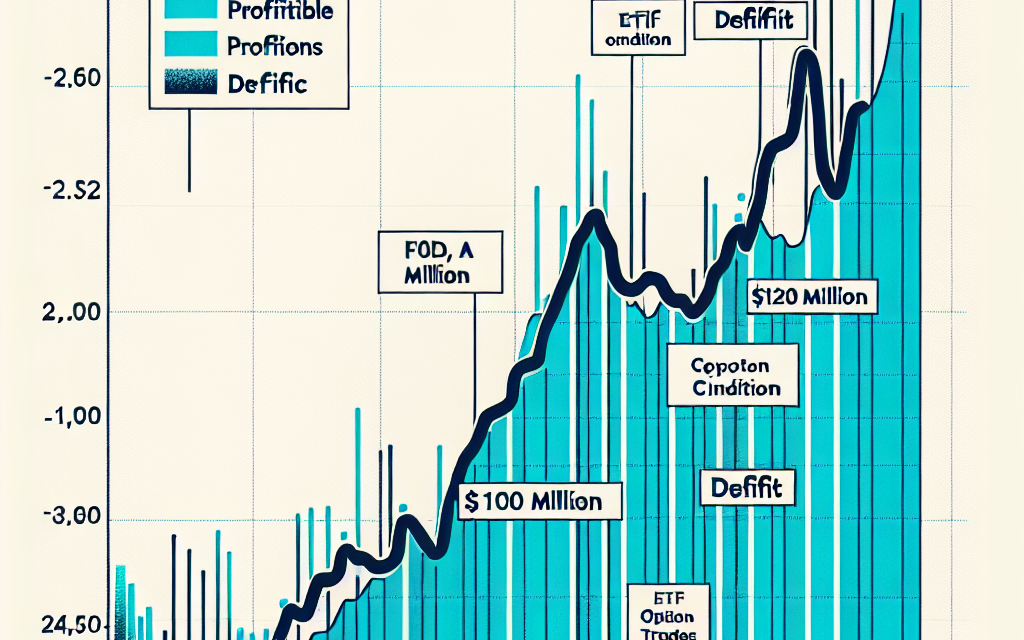“China ETF Options: From Profit Peaks to a $100 Million Deficit Dive.”
Introduction
Recent trends in China ETF option trades have revealed a significant shift from profitability to a staggering $100 million deficit. This change highlights the growing volatility and uncertainty in the Chinese market, driven by various factors including regulatory crackdowns, economic slowdowns, and geopolitical tensions. Investors who once capitalized on the bullish sentiment surrounding Chinese equities are now grappling with losses, prompting a reevaluation of strategies and risk management in the face of an evolving financial landscape. The implications of this shift are profound, affecting not only individual portfolios but also broader market dynamics and investor confidence in China’s economic prospects.
China ETF Performance Analysis
In recent months, the performance of China-focused exchange-traded funds (ETFs) has undergone a significant transformation, shifting from a landscape characterized by profit to one marked by a staggering $100 million deficit. This change can be attributed to a confluence of factors that have influenced investor sentiment and market dynamics. Initially, the allure of China’s rapid economic growth and its burgeoning middle class attracted substantial foreign investment, leading to a period of robust performance for various China ETFs. However, as geopolitical tensions and regulatory uncertainties have escalated, the narrative surrounding these investments has shifted dramatically.
One of the primary drivers of this downturn has been the increasing scrutiny of Chinese companies by both domestic and international regulators. The Chinese government’s crackdown on various sectors, including technology and education, has raised concerns about the sustainability of growth for companies within these industries. Consequently, investors have become more cautious, leading to a decline in capital inflows into China ETFs. This shift in sentiment is further exacerbated by the broader global economic environment, where rising interest rates and inflationary pressures have prompted investors to reassess their risk exposure.
Moreover, the ongoing trade tensions between the United States and China have added another layer of complexity to the investment landscape. As tariffs and sanctions have been imposed, the potential for economic decoupling has loomed large, causing many investors to reevaluate their positions in China-focused assets. This uncertainty has not only affected the performance of individual stocks but has also had a ripple effect on the overall performance of China ETFs. As a result, many funds that once thrived in a favorable economic climate are now grappling with significant losses.
In addition to these external factors, the internal economic conditions within China have also played a crucial role in shaping ETF performance. The country’s post-pandemic recovery has been uneven, with certain sectors rebounding more robustly than others. For instance, while consumer spending has shown signs of recovery, the real estate sector continues to face challenges, impacting the broader economic outlook. This mixed performance has led to volatility in the stock market, further complicating the investment landscape for China ETFs.
As investors navigate this complex environment, the shift from profit to a $100 million deficit in China ETF option trades serves as a stark reminder of the inherent risks associated with investing in emerging markets. The volatility and unpredictability of the Chinese market necessitate a more cautious approach, prompting many investors to reconsider their strategies. In light of these developments, some market participants are exploring alternative investment vehicles or diversifying their portfolios to mitigate risk.
In conclusion, the performance analysis of China ETFs reveals a landscape that has shifted dramatically from one of optimism to one of caution. The interplay of regulatory scrutiny, geopolitical tensions, and internal economic challenges has created a perfect storm that has led to significant losses for many investors. As the market continues to evolve, it is essential for investors to remain vigilant and informed, adapting their strategies to navigate the complexities of investing in China. The lessons learned from this period of transition will undoubtedly shape future investment decisions, underscoring the importance of thorough analysis and risk management in an ever-changing global market.
Impact of Market Volatility on China ETFs
The recent shift in option trades related to China exchange-traded funds (ETFs) has highlighted the profound impact of market volatility on investor sentiment and financial strategies. As the global economic landscape continues to evolve, characterized by fluctuating market conditions and geopolitical tensions, the performance of China ETFs has become increasingly susceptible to these external factors. This volatility has not only affected the underlying assets but has also led to significant changes in trading behaviors, particularly in the options market.
Initially, many investors viewed China ETFs as a promising avenue for capitalizing on the country’s rapid economic growth and expanding consumer market. However, as uncertainties surrounding trade policies, regulatory changes, and economic indicators have emerged, the attractiveness of these investment vehicles has diminished. Consequently, the shift from profit to a staggering $100 million deficit in option trades reflects a broader trend of caution among investors. This transition underscores the growing apprehension regarding the sustainability of returns from China-focused investments.
Moreover, the volatility in the Chinese market has been exacerbated by a series of events, including regulatory crackdowns on technology companies and fluctuating economic data. These developments have not only shaken investor confidence but have also prompted a reevaluation of risk management strategies. As a result, many traders have begun to adopt a more defensive posture, leading to a decline in bullish option positions and an increase in hedging activities. This shift is indicative of a broader trend where investors are prioritizing capital preservation over aggressive growth strategies.
In addition to the immediate financial implications, the volatility surrounding China ETFs has broader ramifications for market dynamics. The significant deficit in option trades signals a potential shift in market sentiment, where investors may be more inclined to seek safer assets or diversify their portfolios away from high-risk investments. This behavior can create a feedback loop, where reduced demand for China ETFs further exacerbates price declines, leading to even greater caution among potential investors.
Furthermore, the impact of market volatility extends beyond individual trading strategies; it also influences institutional investment decisions. Large asset managers and institutional investors are increasingly scrutinizing their exposure to China ETFs, weighing the potential for long-term growth against the backdrop of heightened risk. This careful consideration is essential, as institutional flows can significantly affect market liquidity and price stability. As these entities adjust their strategies in response to market conditions, the overall landscape for China ETFs may continue to evolve, potentially leading to further declines in trading volumes and increased volatility.
In conclusion, the shift from profit to a $100 million deficit in option trades related to China ETFs serves as a stark reminder of the influence of market volatility on investment strategies. As investors grapple with the complexities of the current economic environment, the implications of this volatility are likely to resonate throughout the financial markets. The cautious approach adopted by many traders reflects a broader trend of risk aversion, which may persist as long as uncertainties surrounding the Chinese economy remain. Ultimately, the evolving dynamics of China ETFs will require investors to remain vigilant and adaptable, navigating the challenges posed by an ever-changing market landscape.
Strategies for Navigating China ETF Options
In recent months, the landscape of China ETF option trades has undergone a significant transformation, shifting from a period of profitability to a concerning $100 million deficit. This dramatic change has prompted investors to reevaluate their strategies for navigating the complexities of the China ETF market. As the dynamics of the global economy continue to evolve, understanding the underlying factors influencing these shifts is crucial for making informed investment decisions.
To begin with, it is essential to recognize the broader economic context that has contributed to this downturn. Factors such as geopolitical tensions, regulatory changes, and fluctuating market sentiments have all played a role in shaping investor behavior. Consequently, many traders have found themselves grappling with increased volatility and uncertainty, which can complicate the decision-making process. In light of these challenges, adopting a proactive approach to risk management has become paramount.
One effective strategy for navigating the current landscape involves diversifying investment portfolios. By spreading exposure across various sectors and asset classes, investors can mitigate the impact of adverse movements in any single market. This diversification not only helps to cushion against potential losses but also positions investors to capitalize on opportunities that may arise in different segments of the market. For instance, while certain China ETFs may be underperforming, others could be benefiting from favorable conditions, thus providing a potential avenue for recovery.
Moreover, employing a combination of fundamental and technical analysis can enhance decision-making in the realm of China ETF options. Fundamental analysis allows investors to assess the intrinsic value of underlying assets by examining economic indicators, company performance, and industry trends. On the other hand, technical analysis focuses on price movements and trading volumes, providing insights into market sentiment and potential entry or exit points. By integrating these two approaches, investors can develop a more comprehensive understanding of market dynamics and make more informed trading decisions.
In addition to these analytical strategies, it is also vital for investors to stay abreast of news and developments that may impact the China ETF market. This includes monitoring regulatory changes, economic data releases, and geopolitical events that could influence market sentiment. By remaining informed, investors can better anticipate potential market shifts and adjust their strategies accordingly. Furthermore, engaging with financial news platforms and expert analyses can provide valuable insights that may not be immediately apparent through traditional research methods.
Another important consideration is the timing of trades. Given the current volatility in the China ETF options market, employing a disciplined approach to timing can significantly impact overall performance. Investors should consider utilizing limit orders to control entry and exit points, thereby reducing the risk of unfavorable price movements. Additionally, implementing stop-loss orders can help protect against significant losses by automatically selling positions when they reach a predetermined price level.
Ultimately, navigating the complexities of China ETF options in the face of a $100 million deficit requires a multifaceted approach. By diversifying portfolios, employing a blend of analytical strategies, staying informed about market developments, and carefully timing trades, investors can enhance their chances of success in this challenging environment. As the market continues to evolve, those who remain adaptable and proactive will be better positioned to weather the storm and seize opportunities as they arise. In conclusion, while the current landscape may present challenges, it also offers avenues for strategic engagement that can lead to potential recovery and growth in the future.
Historical Trends in China ETF Profitability
In recent years, the landscape of exchange-traded funds (ETFs) focused on China has undergone significant transformations, particularly in terms of profitability. Historically, China ETFs have attracted considerable investor interest due to the country’s rapid economic growth and its status as a global manufacturing powerhouse. This interest was reflected in the robust performance of many China-focused funds, which often yielded substantial returns for investors. However, as market dynamics evolved, so too did the profitability of these investment vehicles.
Initially, the allure of China ETFs was driven by the country’s impressive GDP growth rates, which consistently outpaced those of developed economies. Investors were drawn to the potential for high returns, leading to a surge in capital inflows into these funds. This trend was further bolstered by the increasing accessibility of Chinese markets, as regulatory reforms allowed foreign investors to participate more freely. Consequently, many ETFs that focused on Chinese equities experienced significant appreciation in their net asset values, creating a favorable environment for profit generation.
However, as the years progressed, various factors began to challenge the profitability of China ETFs. One of the most notable influences was the tightening of monetary policy by the Chinese government, aimed at curbing excessive debt and managing inflation. This shift in policy led to increased volatility in the Chinese stock market, which, in turn, affected the performance of ETFs. Investors began to reassess their positions, leading to a more cautious approach toward China-focused investments. As a result, many funds that once thrived in a booming market found themselves grappling with declining returns.
Moreover, geopolitical tensions and trade disputes, particularly between the United States and China, further complicated the investment landscape. These tensions not only created uncertainty for investors but also led to increased scrutiny of Chinese companies, particularly those listed on foreign exchanges. The implications of such scrutiny were profound, as many investors became wary of potential regulatory crackdowns and the associated risks. Consequently, this environment of uncertainty contributed to a shift in sentiment, with many investors opting to reduce their exposure to China ETFs.
As we moved into the latter part of the decade, the profitability of China ETFs continued to decline, culminating in a notable shift from profit to significant deficits. The once-promising outlook for these funds was overshadowed by a series of disappointing earnings reports from major Chinese corporations, coupled with a broader market downturn. This shift was starkly illustrated by the recent reports indicating that option trades related to China ETFs had transitioned from a position of profitability to a staggering $100 million deficit. Such a dramatic change underscores the challenges that investors now face in navigating the complexities of the Chinese market.
In conclusion, the historical trends in China ETF profitability reveal a narrative of initial promise followed by increasing challenges. While the early years were characterized by robust growth and investor enthusiasm, subsequent developments have led to a more cautious and, at times, pessimistic outlook. As investors continue to grapple with the implications of regulatory changes, geopolitical tensions, and market volatility, the future of China ETFs remains uncertain. The transition from profit to deficit serves as a stark reminder of the inherent risks associated with investing in emerging markets, particularly in a landscape as dynamic and complex as that of China.
Risk Management in China ETF Trading
In recent months, the landscape of China ETF trading has undergone a significant transformation, particularly in the realm of risk management. As traders and investors navigate the complexities of the Chinese market, the shift from profit to a staggering $100 million deficit in option trades has raised critical questions about the strategies employed in managing risk. This development underscores the importance of understanding the inherent volatility associated with China-focused investments and the necessity for robust risk management frameworks.
To begin with, the volatility of the Chinese market is influenced by a myriad of factors, including regulatory changes, economic indicators, and geopolitical tensions. These elements can lead to rapid price fluctuations, making it imperative for traders to adopt a proactive approach to risk management. In this context, the use of options as a hedging tool has become increasingly prevalent. However, the recent shift in option trades indicates that many investors may have underestimated the risks involved, leading to substantial financial losses.
Moreover, the transition from profit to deficit highlights the need for a comprehensive understanding of market dynamics. Traders must not only analyze historical data but also stay informed about current events that could impact the Chinese economy. For instance, changes in government policy or unexpected economic reports can create significant market movements, necessitating a reevaluation of existing positions. Consequently, effective risk management requires continuous monitoring and adjustment of strategies to align with the evolving market landscape.
In addition to staying informed, diversification remains a cornerstone of risk management in China ETF trading. By spreading investments across various sectors and asset classes, traders can mitigate the impact of adverse market movements on their overall portfolio. This approach not only reduces exposure to individual stock volatility but also enhances the potential for stable returns. However, it is essential to recognize that diversification alone cannot eliminate risk; rather, it serves as a complementary strategy to more targeted risk management techniques.
Furthermore, the implementation of stop-loss orders is another critical component of risk management. By setting predetermined exit points, traders can limit potential losses and protect their capital in the event of unfavorable market conditions. This strategy is particularly relevant in the context of China ETFs, where sudden market shifts can occur with little warning. By employing stop-loss orders, investors can maintain greater control over their trades and reduce the emotional stress associated with market volatility.
As the recent deficit in option trades illustrates, the importance of education and training in risk management cannot be overstated. Investors must equip themselves with the necessary knowledge and skills to navigate the complexities of the Chinese market effectively. This includes understanding the intricacies of options trading, as well as the broader economic and political factors that influence market behavior. By investing in education, traders can enhance their decision-making processes and develop more effective risk management strategies.
In conclusion, the shift from profit to a $100 million deficit in China ETF option trades serves as a stark reminder of the importance of risk management in trading. As the market continues to evolve, traders must remain vigilant and adaptable, employing a combination of strategies such as diversification, stop-loss orders, and continuous education. By doing so, they can better navigate the challenges posed by the Chinese market and work towards achieving more consistent and sustainable investment outcomes. Ultimately, effective risk management is not merely a reactive measure; it is a proactive approach that can significantly enhance the potential for long-term success in China ETF trading.
The Role of Economic Indicators in China ETF Options
In recent months, the landscape of China ETF option trades has undergone a significant transformation, shifting from a phase of profitability to a concerning $100 million deficit. This change can be largely attributed to the evolving economic indicators that reflect the health of China’s economy. As investors closely monitor these indicators, their reactions have profound implications for the trading strategies employed in the realm of exchange-traded funds (ETFs) focused on China.
Economic indicators serve as critical barometers for assessing the performance and potential trajectory of an economy. In the case of China, key indicators such as GDP growth rates, manufacturing output, and consumer spending have become focal points for investors. For instance, a slowdown in GDP growth can signal underlying weaknesses in the economy, prompting investors to reassess their positions in China-focused ETFs. Consequently, when economic data releases indicate a downturn, the sentiment among traders can shift rapidly, leading to increased volatility in option pricing and trading volumes.
Moreover, the recent fluctuations in China’s economic indicators have been exacerbated by external factors, including geopolitical tensions and global market dynamics. As trade relations between China and other major economies fluctuate, the uncertainty surrounding these interactions can lead to heightened caution among investors. This caution often manifests in the form of reduced trading activity or a shift towards more defensive strategies, which can further contribute to the observed deficit in China ETF option trades.
In addition to macroeconomic indicators, sector-specific data also plays a crucial role in shaping investor sentiment. For example, the performance of China’s technology sector, which has been a significant driver of economic growth, is closely watched by traders. Any signs of regulatory crackdowns or shifts in government policy can lead to rapid adjustments in trading strategies. As a result, when negative news emerges regarding a particular sector, it can trigger a wave of selling in related ETFs, amplifying the impact on option trades.
Furthermore, the psychological aspect of trading cannot be overlooked. Investor sentiment is often influenced by the prevailing narrative surrounding China’s economic prospects. When positive indicators emerge, such as robust export figures or strong consumer confidence, traders may be more inclined to take on risk, leading to increased buying activity in China ETFs. Conversely, negative news can create a sense of panic, prompting a rush to sell and exacerbating the deficit in option trades.
As the situation continues to evolve, it is essential for investors to remain vigilant and adaptable. The interplay between economic indicators and market sentiment will likely dictate the future trajectory of China ETF option trades. Understanding the nuances of these indicators and their implications for market behavior can provide valuable insights for traders seeking to navigate this complex landscape.
In conclusion, the shift from profitability to a $100 million deficit in China ETF option trades underscores the critical role that economic indicators play in shaping investor behavior. As traders respond to both macroeconomic and sector-specific data, the resulting volatility can significantly impact trading strategies. By staying informed and responsive to these indicators, investors can better position themselves to navigate the challenges and opportunities presented by the ever-changing dynamics of the Chinese economy.
Future Outlook for China ETF Investments
The landscape of China ETF investments has undergone a significant transformation, particularly in light of recent trading patterns that indicate a shift from profit to a staggering $100 million deficit. This change raises important questions about the future outlook for these investment vehicles, which have long been considered a gateway for international investors seeking exposure to the Chinese market. As we delve into the implications of this shift, it becomes essential to consider various factors that may influence the trajectory of China ETFs moving forward.
To begin with, the recent downturn in profitability can be attributed to a confluence of economic and geopolitical factors. The Chinese economy has faced headwinds, including slowing growth rates, regulatory crackdowns on key sectors, and ongoing trade tensions with major economies. These elements have not only affected investor sentiment but have also led to increased volatility in the markets. Consequently, the once-promising outlook for China ETFs has dimmed, prompting many investors to reassess their strategies and risk tolerance.
Moreover, the changing dynamics of global investment flows cannot be overlooked. As investors become more discerning, they are increasingly seeking opportunities that offer stability and growth potential. In this context, the allure of China ETFs may wane if the underlying economic conditions do not improve. Investors are likely to pivot towards markets that demonstrate resilience and a clearer path to recovery, which could further exacerbate the challenges faced by China-focused funds. This shift in investor behavior underscores the importance of adaptability in the investment landscape.
In addition to economic factors, regulatory developments in China have also played a pivotal role in shaping the future of ETF investments. The Chinese government has implemented a series of measures aimed at tightening control over various sectors, including technology and finance. While these regulations are intended to foster long-term stability, they have created an environment of uncertainty that can deter foreign investment. As a result, the perception of risk associated with China ETFs has increased, leading to a cautious approach among potential investors.
Furthermore, the competitive landscape for ETFs is evolving, with a growing number of alternatives emerging in the global market. Investors now have access to a diverse array of funds that focus on different regions and sectors, which may dilute the appeal of China-specific investments. As new opportunities arise, particularly in emerging markets that exhibit robust growth potential, the allocation of capital may shift away from China ETFs, further impacting their performance.
Looking ahead, the future of China ETF investments will likely hinge on several key developments. First and foremost, the trajectory of the Chinese economy will be critical. Should growth stabilize and regulatory clarity improve, investor confidence may gradually return, potentially revitalizing interest in these funds. Additionally, geopolitical relations will play a significant role; a thawing of tensions with major trading partners could enhance the attractiveness of China as an investment destination.
In conclusion, while the current landscape for China ETF investments appears challenging, it is essential to recognize that markets are inherently cyclical. The potential for recovery exists, contingent upon favorable economic indicators and a more stable regulatory environment. As investors navigate this complex terrain, a nuanced understanding of the factors at play will be crucial in making informed decisions about the future of their investments in China ETFs. Ultimately, the ability to adapt to changing conditions will determine the success of these investment vehicles in the years to come.
Q&A
1. **What is the main reason for the shift in China ETF option trades from profit to a $100 million deficit?**
– The shift is primarily due to increased market volatility and geopolitical tensions affecting investor sentiment.
2. **Which specific China ETFs are most impacted by this deficit?**
– ETFs such as the iShares China Large-Cap ETF (FXI) and the KraneShares CSI China Internet ETF (KWEB) have been notably affected.
3. **How have option traders adjusted their strategies in response to the deficit?**
– Traders have shifted to more conservative strategies, such as hedging or reducing exposure to high-risk options.
4. **What role do macroeconomic factors play in this situation?**
– Macroeconomic factors, including slowing economic growth in China and tightening monetary policy, have contributed to the negative sentiment.
5. **Are institutional investors more affected than retail investors in this scenario?**
– Yes, institutional investors typically have larger positions and are more exposed to the volatility, leading to greater financial impact.
6. **What are the potential long-term implications of this deficit for China-focused investments?**
– Long-term implications may include reduced investor confidence and a potential reevaluation of risk associated with China-focused investments.
7. **How might this situation influence future ETF option trading strategies?**
– Future strategies may focus on risk management and diversification, with an emphasis on sectors less affected by geopolitical risks.
Conclusion
The shift in China ETF option trades from profit to a $100 million deficit indicates a significant change in market sentiment and investor confidence. This decline may be attributed to various factors, including geopolitical tensions, economic uncertainties, and regulatory challenges affecting Chinese markets. As investors reassess their strategies in light of these developments, the transition from profitability to substantial losses underscores the volatility and risks associated with investing in China-focused assets.





